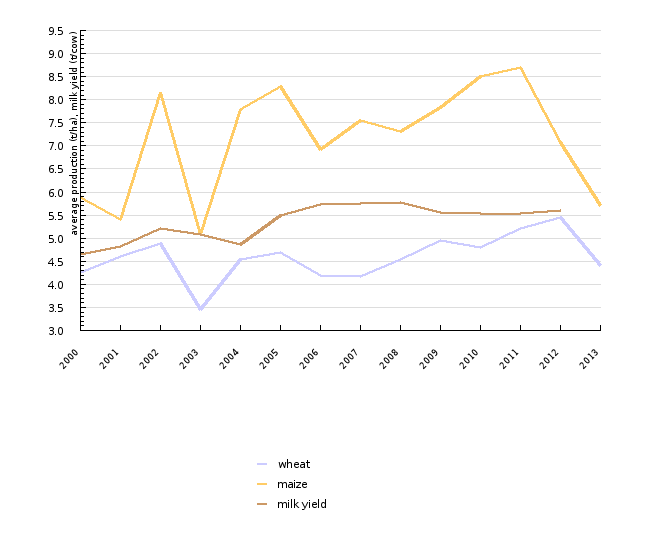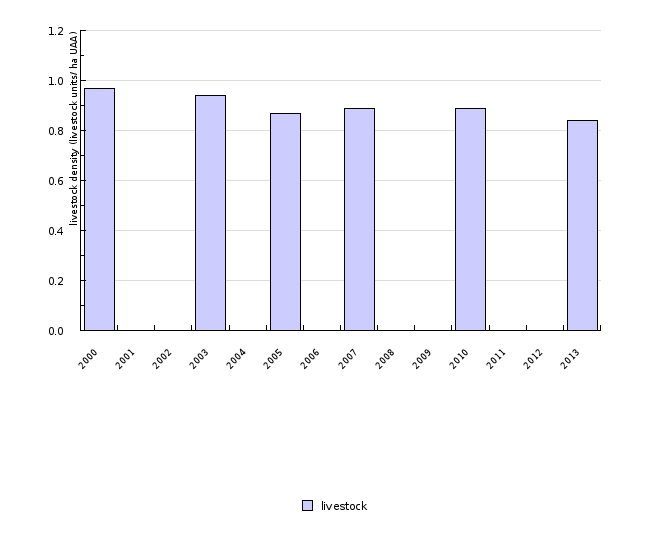[KM04] Intensification of agriculture

Key message

Intensity in agricultural production is moderately increasing.
Charts
Statistical Office of the Republic of Slovenia, 2013; claculations by the Agricultural Institute of Slovenia, Institute of Macroeconomic Analysis and Developmentm Slovenian Environment Agency, 2013
| 2000 | 2001 | 2002 | 2003 | 2004 | 2005 | 2006 | 2007 | 2008 | 2009 | ||
|---|---|---|---|---|---|---|---|---|---|---|---|
| wheat | t/ha | 4 | 5 | 5 | 3 | 5 | 5 | 4 | 4 | 5 | 5 |
| maize | t/ha | 6 | 5 | 8 | 5 | 8 | 8 | 7 | 8 | 7 | 8 |
| milk yield | t/cow | 5 | 5 | 5 | 5 | 5 | 5 | 6 | 6 | 6 | 6 |
| 2010 | 2011 | 2012 | 2013 | ||||||||
| wheat | t/ha | 5 | 5 | 5 | 4 | ||||||
| maize | t/ha | 9 | 9 | 7 | 6 | ||||||
| milk yield | t/cow | 6 | 6 | 6 |
Statistical Office of the Republic of Slovenia, 2013; claculations by the Agricultural Institute of Slovenia, Institute of Macroeconomic Analysis and Developmentm Slovenian Environment Agency, 2013.
| 2000 | 2001 | 2002 | 2003 | 2004 | 2005 | 2006 | 2007 | 2008 | 2009 | ||
|---|---|---|---|---|---|---|---|---|---|---|---|
| livestock | livestock units/ha UAA | 1 | 1 | 1 | 1 | ||||||
| 2010 | 2011 | 2012 | 2013 | ||||||||
| livestock | livestock units/ha UAA | 1 | 1 |
Goals
Past experiences show that the intensification of agriculture in uncontrolled conditions is a process which can present one of the most extensive burdens on nature and the environment. These facts have made it one of the focal themes in strategic and programme documents of the European agricultural and environmental policy. The Water and Nitrates directives are the key environmental instruments limiting the possible negative consequences of intensification in agriculture. Agri-environmental concepts also present an important element of the reform of the agricultural policy. The importance of the protection of the environment in agriculture is increasing by means of the so-called cross-compliance and introduction of other measures for the achievement of ecological standards. Farmers eligible for financial support have to observe the prescribed standards regulating the environment, safe food and well-being of animals. They must also maintain their agricultural land in compliance with good farming practice. The importance of environmental concepts and measures in the framework of the rural development policy is increasing as well. Slovenia, too, committed itself to observe these rules by planning the implementation of the agricultural policy reform.
Comment
In Slovenia, the level of intensification in agriculture is moderate, focusing primarily on improving labour productivity in agricultural production, i.e.
reducing the input of labour per unit of area or product.
The intensification of agriculture allows agricultural production with lower costs per unit of agricultural product i.e. the cost labour, the land and
capital. However, past experience has shown that its consequences, such as the increased use of fertilisers and plant-protection products, loss of
biodiversity for spatial development etc., leads to the greatest burdening on the environment; accordingly, intensification has become the focal theme of
agricultural and environmental policies which develop instruments to limit its negative effects.
Almost 80% of all agricultural holdings in Slovenia are engaged in various types of livestock breeding, 47% of which are engaged in cattle breeding. The
number of farmers engaged in cattle breeding decreased by almost one fourth in the 2000–2013 period alone. As in other EU countries, stock density (the
number of livestock units per hectare of utilised agricultural area) is also decreasing in Slovenia; it declined by almost 9% (from 0.97 to 0.84 of
livestock unit/ha) in the 2000- 2013 period alone.
In spite of a rapid decrease in the number of holdings engaged in dairying, and a slightly less distinct decline in the number of dairy cows on these
holdings, the total milk yield has remained almost unchanged The reason for this is a notable increase in the concentration of dairying: in the 2000- 2013
period, the average number of cows per holding rose by more than 50%, and at the same time, the intensity of dairying increased. In ten years, average milk
production per dairy cow (milk yield) increased by more than 25% to stand at 5.6 tonnes of milk per cow in 2012.
Wheat and grain maize are the most important crops in Slovenia. According to data from the Statistical Office of the Republic of Slovenia, 31 thousand
(wheat) and 42 thousand (maize) hectares of arable land were harvested in 2013. The concentration of production is distinctly increasing (average area of
wheat and maize per holding), whereas the increase in hectare yield is less significant, which is due to the high dependence on weather conditions.










